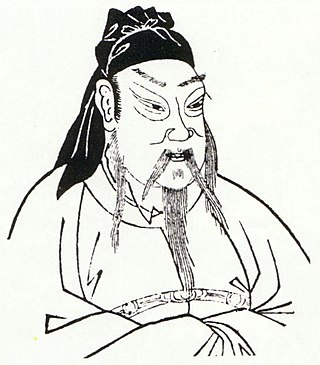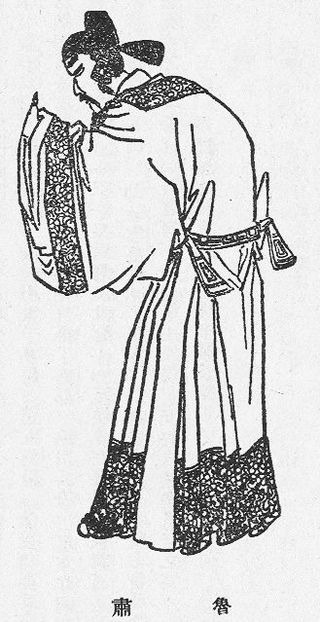Related Research Articles

Guan Yu, courtesy name Yunchang, was a Chinese military general serving under the warlord Liu Bei during the late Eastern Han dynasty of China. Along with Zhang Fei, he shared a brotherly relationship with Liu Bei and accompanied him on most of his early exploits. Guan Yu played a significant role in the events leading up to the end of the Han dynasty and the establishment of Liu Bei's state of Shu Han during the Three Kingdoms period. While he is remembered for his loyalty towards Liu Bei, he is also known for repaying Cao Cao's kindness by slaying Yan Liang, a general under Cao Cao's rival Yuan Shao, at the Battle of Boma. After Liu Bei gained control of Yi Province in 214, Guan Yu remained in Jing Province to govern and defend the area for about seven years. In 219, while he was away fighting Cao Cao's forces at the Battle of Fancheng, Liu Bei's ally Sun Quan broke the Sun–Liu alliance and sent his general Lü Meng to conquer Liu Bei's territories in Jing Province. By the time Guan Yu found out about the loss of Jing Province after his defeat at Fancheng, it was too late. He was subsequently captured in an ambush by Sun Quan's forces and executed.

Lü Meng, courtesy name Ziming, was a Chinese military general and politician who served under the warlord Sun Quan during the late Eastern Han dynasty of China. Early in his career, he fought in several battles under the banner of Sun Ce, Sun Quan's elder brother and predecessor. Although he had been noted for his bravery, he was still deemed as nothing more than a "mere warrior" for his lack of literacy skills. Later, with encouragement from Sun Quan, Lü Meng took up scholarly pursuits to improve himself, gradually becoming a learned and competent military leader. In 217, he succeeded Lu Su as the frontline commander of Sun Quan's forces in Jing Province. Two years later, in a carefully calculated military operation, Lü Meng led an invasion of Liu Bei's territories in southern Jing Province, swiftly and stealthily capturing all the lands from Liu Bei's general Guan Yu, who was captured and executed after his defeat. Lü Meng enjoyed his finest hour after the victory but died a few months later because he was already seriously ill before the campaign.

Gan Ning, courtesy name Xingba, was a Chinese military general serving under the warlord Sun Quan in the late Eastern Han dynasty. Originally a notorious pirate, he gave up the life of a marauder in the late 190s and became a subordinate of Huang Zu, the Administrator of a commandery in present-day east-central Hubei. Disheartened by Huang Zu's indifferent attitude towards him, Gan Ning eventually left Huang and made his way into Wu territory, where he found his calling and became a military officer under the warlord Sun Quan. Throughout his years of service under Sun Quan until his death, Gan Ning fought in numerous battles for his lord, including the battles of Jiangxia (208), Red Cliffs (208–209), Xiaoyao Ford (214–215) and Ruxu (217).

Zhou Tai, courtesy name Youping, was a military general serving under the warlord Sun Quan during the late Eastern Han dynasty and early Three Kingdoms period of China. He previously served under Sun Ce, Sun Quan's elder brother and predecessor.
Dong Xi, courtesy name Yuanshi, was a military general serving under the warlords Sun Ce and Sun Quan during the late Eastern Han dynasty of China.
Xu Sheng, courtesy name Wenxiang, was a military general serving under the warlord Sun Quan in the late Eastern Han dynasty and early Three Kingdoms period of China.

Lu Su (172–217), courtesy name Zijing, was a Chinese military general and politician serving under the warlord Sun Quan during the late Eastern Han dynasty. In the year 200, when Sun Quan had just taken over the reins of power, his adviser Zhou Yu recommended Lu Su as a talent to Sun Quan. As one of Sun Quan's most important advisers in the warlord's early career, Lu Su is best known for making some significant contributions. Firstly, in 200 he drafted a long-term strategy for Sun Quan's power bloc to emerge as one of three major contending powers in China – a plan similar to Zhuge Liang's Longzhong Plan, which was proposed about seven years later. Secondly, before the Battle of Red Cliffs in late 208, he was the first person to persuade Sun Quan to ally with Liu Bei against Cao Cao. Thirdly, he succeeded Zhou Yu as the frontline commander of Sun Quan's forces in 210 after Zhou's death and maintained the Sun–Liu alliance. Fourthly, in 215, he represented Sun Quan at the negotiations with Liu Bei's general Guan Yu during the Sun–Liu territorial dispute over Jing Province.
Jiang Qin, courtesy name Gongyi, was a military general and naval specialist serving under the warlord Sun Quan during the late Eastern Han dynasty of China. He previously served under Sun Quan's elder brother and predecessor, Sun Ce, and participated in various battles throughout his service under the Sun family, including Sun Ce's conquests in Jiangdong, the Battle of Xiaoyao Ford and Lü Meng's invasion of Jing Province, twice holding joint command of the Sun armies.
Ling Tong (189–217), courtesy name Gongji, was a Chinese military general serving under the warlord Sun Quan during the late Eastern Han dynasty of China. He started his service under Sun Quan when he was still a teenager and, throughout his entire life, had been contributing to the foundation and solidification of the state of Eastern Wu, which Sun Quan established in 229. He fought in numerous battles for his lord, including those against Huang Zu, Liu Bei and the Shanyue tribes, but is best known for his performance in the campaigns against Sun Quan's archrival Cao Cao, in which he displayed great skill and tact in extremely adverse situations.
Luo Tong, courtesy name Gongxu, was an official serving under the warlord Sun Quan during the late Eastern Han dynasty and early Three Kingdoms period of China.
Zhang Cheng (178–244), courtesy name Zhongsi, was a military general of the state of Eastern Wu during the Three Kingdoms period of China.
Pan Zhang, courtesy name Wengui, was a military general serving under the warlord Sun Quan during the late Eastern Han dynasty of China. He continued serving in the state of Eastern Wu during the Three Kingdoms period until his death. Pan Zhang was praised by Chen Shou as one of the "twelve tiger minister of Jiangdong" (江東十二虎臣).
Bu Zhi, courtesy name Zishan, was a Chinese military general and politician of the state of Eastern Wu during the Three Kingdoms period of China. Originally a scholar of humble background, he became a subordinate of the warlord Sun Quan in the late Eastern Han dynasty and gradually rose through the ranks. Between 210 and 220, he served as the governor of the remote and restive Jiao Province in southern China. During the Battle of Xiaoting/Yiling of 221–222, he quelled local uprisings in Sun Quan's territories in southern Jing Province and maintained peace in the area. After Sun Quan became emperor in 229, Bu Zhi oversaw the Wu armed forces guarding the Wu–Shu border at Xiling for about 20 years. During this time, he also gave advice to Sun Quan's first heir apparent, Sun Deng, and spoke up for officials affected by Lü Yi's abuses of power. In 246, he became the fourth Imperial Chancellor of Wu, but died in office in the following year.

Lü Meng's invasion of Jing Province was fought between the warlords Sun Quan and Liu Bei in the winter of 219–220 in the late Eastern Han dynasty. Sun Quan's forces, led by Lü Meng, invaded Liu Bei's territories in southern Jing Province, which covered present-day Hubei and Hunan. The campaign occurred after the Battle of Fancheng and concluded with victory for Sun Quan's forces, who completely captured all of Liu Bei's territories. Guan Yu, Liu Bei's general guarding those territories, was captured and executed by Sun Quan's forces. The fall of Jing Province and Guan Yu's death provided the trigger for the Battle of Xiaoting between Liu Bei and Sun Quan between 221 and 222.
The following is the order of battle for the Battle of Red Cliffs.
Zhu Huan (177–238), courtesy name Xiumu, was a military general of the state of Eastern Wu during the Three Kingdoms period of China. Although he started his career early under the warlord Sun Quan, he did not receive any important responsibilities until after the Battle of Jiangling in 209. Since then, Zhu Huan had taken charge of some local defences and successfully quelled a few rebellions. Between 222 and 225, when Cao Pi, the emperor of Wu's rival state Wei, launched a three-pronged invasion of Wu, Sun Quan appointed Zhu Huan as a military commander to resist the Wei invaders. Zhu Huan defeated the Wei general Cao Ren at the Battle of Ruxu (222–223).
The Battle of Dongxing, also known as the Battle of Dongguan, was fought from January to February 253 between the states of Cao Wei and Eastern Wu during the Three Kingdoms period of China. The battle concluded with a tactical victory for Wu.
The Battle of Dongkou was a naval battle fought between October 222 and January 223 between forces of the state of Cao Wei and the Kingdom of Wu during the Three Kingdoms period of China. The battle concluded in a Wu victory.
The Battle of Jiangling was fought between the forces of the Cao Wei and Eastern Wu dynasties in the early Three Kingdoms period of China. The battle, which took place around present-day Jiangling County, Hubei, was an integral part of the Wei emperor Cao Pi's three-pronged campaign against the Wu leader Sun Quan. It spanned a period of about six months from October 222 to April 223. Of the three fronts, the most critical Wei attacks were concentrated against the Wu fortress at Jiangling.
The Sun–Liu territorial dispute was a military conflict between the warlords Sun Quan and Liu Bei in 215 during the late Eastern Han dynasty of China. While Sun Quan and Liu Bei had initially formed an alliance in 208 against their common rival Cao Cao, both sides got into a territorial dispute over the territories in southern Jing Province in the early 210s. The dispute ended when both sides agreed to divide the territories along the Xiang River between their respective domains: Sun Quan took the lands east of the river while Liu Bei kept those west of the river. Despite a peaceful settlement to the territorial dispute, Sun Quan ultimately sent his forces to attack Liu Bei's territories in an invasion in 219 and succeeded in capturing all of them.
References
- ↑ (魏使廬江謝奇為蘄春典農,屯皖田鄉,數為邊寇) Sanguozhi vol. 54.
- ↑ (伺隙襲擊,奇遂縮退) Sanguozhi vol. 54.
- ↑ (權特為案行至濡須塢,因會諸將,大為酣樂) Sanguozhi vol. 55.
- ↑ (盛獨將兵,上突斫敵,敵披退走,有所傷殺) Sanguozhi vol. 55.
- ↑ (後從權拒曹公於濡須,數近奇計,又勸權夾水口立塢,所以備御甚精) Sanguozhi vol. 54.
- ↑ (時乘蒙沖,遇迅風,船落敵岸下) Sanguozhi vol. 55.
- ↑ (权守合肥十馀日,城不可拔,乃引退) Sanguozhi vol. 17.
- ↑ (辽率诸军追击,几复获权. 太祖大壮辽,拜征东将军. 建安二十一年,太祖复征孙权,到合肥,循行辽战处,叹息者良久.) Sanguozhi vol. 17.
- ↑ (後從攻皖,為升城督. 寧手持練,身緣城,為吏士先,卒破獲朱光.) Sanguozhi vol. 55.
- ↑ (後曹公出濡須,寧為前部督,受敕出斫敵前營) Sanguozhi vol. 55.
- ↑ (曹公出濡須,從權御之) Sanguozhi vol. 55.
- ↑ (魏嘗大出橫江,盛與諸將俱赴討) Sanguozhi vol. 55.
- Chen, Shou (3rd century). Records of the Three Kingdoms , volumes 17, 54, 55.